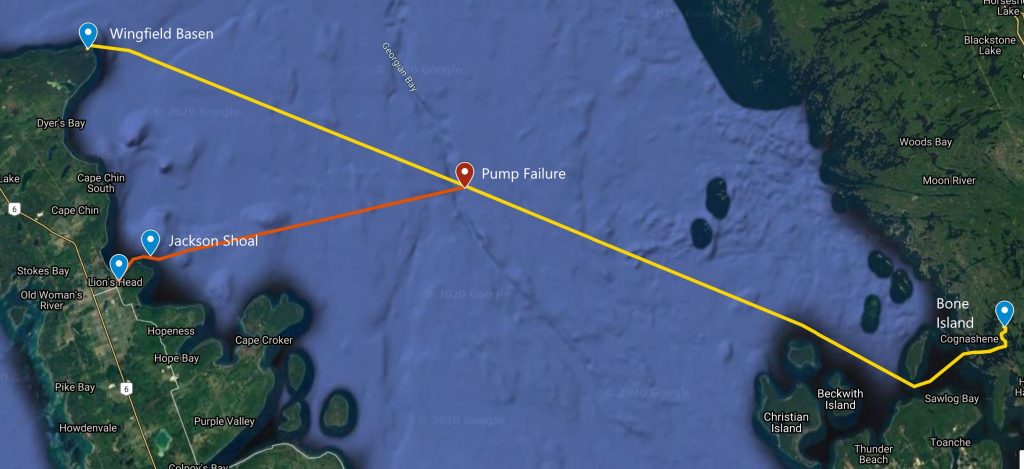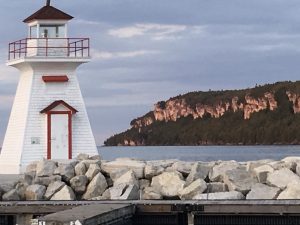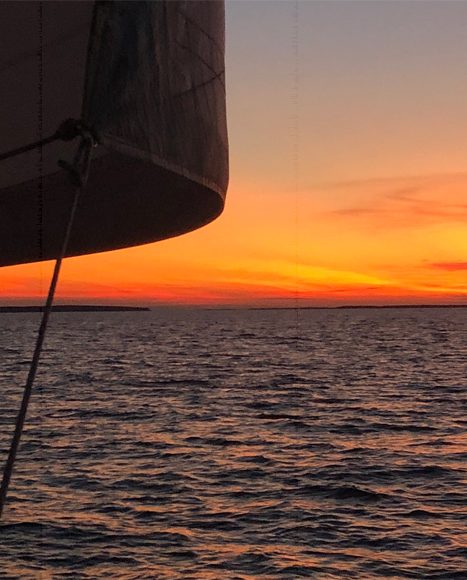I awoke to the first strains of Carlos Santana’s dulcet guitar intro to his duet with John Lee Hooker on The Healer. It was pitch black in our berth at the back of Gaviidae and my cell phone alarm was telling me it was time to rise and shine. Sunrise was an hour away and a predawn fog hung dark and cold and damp over the bay like a sodden quilt. Neither breezes nor current stirred our sailboat as she floated serenely within the protective embrace of Bone Island in Georgian Bay.
A quick look out the portside window in our cabin revealed nothing about our position within the anchorage. No shoreline was visible. No tree line. No stars. No sign of any of the half-dozen motor cruisers and sailboats I knew to be anchored nearby. The view through the port was featureless beyond the teak-capped toe rail and stainless-steel stanchion a little more than a foot from the port. I would need to consult a compass to determine our orientation.
End of the Season?
This was a big day. It was September 15 and the Georgian Bay Rally for the Great Lakes Cruising Club had concluded the previous evening. It was the last hurrah for most attendees’ 2019 sailing season before heading back to home ports to get ready for winter. Including us.
Since leaving Goderich, ON June 11, our summer cruise split into three nearly equal segments. We spent about a month on Lakes Huron and Michigan, another month in the North Channel and three weeks in Georgian Bay. Julie and I cleared Killarney August 22 and wandered down the east side of Georgian Bay for a week buddy boating with our friends, Jerry and Clare on SV Magic Carpet and later with David and Kathy on SV Good Idea. Both crews had extensive knowledge of the area.
We followed convoluted, but well-buoyed small craft routes through the Thirty Thousand Islands region all the way to Midland—some 140 miles. I’ve read that the Thirty Thousand Islands is the world’s largest freshwater archipelago, and I can attest that three weeks is not nearly enough to thoroughly explore it by sailboat, but it was time to get back to Goderich.
We planned to steer Gaviidae through the labyrinthine islands and channels to the open water beyond Giant’s Tomb Island, some 12 nautical miles southeast. From Giant’s Tomb Island we would steer west by north 60 miles across Georgian Bay to Cabot Head on the northeast corner of the Bruce Peninsula. The Bruce defines most of the eastern edge of Georgian Bay. With an early start, we could drop anchor in Wingfield Basin on Cabot Head before sunset.
I dressed in the dark and nudged Julie from her slumber before climbing the companionway steps into the cockpit. The cockpit enclosure windows and the windscreen were all covered in the ghostly wet sheen of the fog that still hung over the anchorage.
Dodging Rocks
We heated water for Julie’s coffee and my tea and a breakfast of oatmeal with raisins and brown sugar. The anchorage was still dead calm when we fired up the diesel at 0635. The fog lifted as the morning light quickened and we wiped down fogged-up windows. The sky was mostly clear yet we inexplicably found ourselves in a light shower as I went forward to raise the anchor and take bow watch. Although we closely followed our track into the harbor on our Navionics chart, one of us always goes forward to watch for rocks, deadheads and small watercraft that make passage making through narrow channels so exciting.
As we wound our way through the channels flanked by islands, islets, visible rocks and submerged obstacles the wind came up. We were recording seven-to-nine knot westerlies. Once we cleared the twistier channels and could cruise in a more direct heading we put out the staysail, then the main, and motor sailed. The wind was still pushing nine knots, but now out of the north as we cruised toward and around Giant’s Tomb Island.
As we rounded the south end of the island and headed into more open water the wind began to falter. Still northerly, the wind dropped to under five knots as we motor sailed past Hope Island. When the wind dropped below two knots south of the Western Islands at noon, we rolled up the staysail and soldiered on with the mainsail deployed. The mainsail was mostly for show; the Iron Genny was keeping our speed over ground at nearly seven knots. The Iron Genny is a sailor’s term for the engine when it is used to power the boat. “Genny” is a play on genoa, the forward-most sail. At that that speed, we would arrive at our destination between 1800 and 1900 hours—about 6:30 p.m. for you landlubbers–with plenty of daylight to get into the cove and anchored.
Bad Whine
A couple hours and some 15 miles beyond the Westerns, an uncharacteristic whine began emanating from below decks. A quick check of the gauges on the helm indicated no problems, but I went below to investigate. New sounds from a running diesel should not be ignored.
I raised the companionway access to the front of the engine compartment and was confronted with a water-filled catch pan below the engine. Through the roar of the diesel, I followed the noise to the left of the engine–near the alternator. There I saw water spraying below and behind the alternator, where the sea water pump is located. That pump is also known as the raw water pump; it provides sea or lake water to the engine’s cooling system. It is essential. I shouted to Julie to shut down the engine. It was then that I could hear the bilge pump at work below my feet.
I immediately closed the through hull valve supplying the cold water, which stopped the water spray. I checked the water level in the bilge. It was just a little above the bilge pump, so no imminent threat loomed there. I then turned my attention back to the sea water pump, with which I already had a more-than-passing acquaintance.
The Pump (Again)
I installed this sea water pump myself in 2015 at Port Washington, Long Island, when its predecessor failed. In that case, there was no water spray. A telltale scattering of tiny ball bearings in the engine pan alerted me to a problem before we cruised into New York City. Not seeing any ball bearings at the bottom of the pan this time, I optimistically reasoned that the pump was too new to fail. I guessed that it was just a loosened clamp on one of the water hoses attached to the sea water pump. At worst, I thought it might be a hose failure.
Tugging, pushing and squeezing the attached hoses, I found no loose hose clamps. Nor could I find any breaks, splits or other signs of hose failure. However, the pump was hot to the touch. That suggested the pump itself had a problem. The engine, alternator and pump would all have to cool down before I could start dismantling things and get a better look at the pump.
Offshore Drifting
At the time, we were more than halfway to our destination on the Bruce Peninsula still 28 miles to the northwest. We were in the middle of Georgian Bay 25 miles or more from any land, other than the Western Islands. Consequently, we had no radio, internet or telephone connectivity. In fact, we hadn’t seen another boat since we cleared Hope Island three hours earlier and had heard no radio chatter. On top of all that, the wind all but died.
Changing Course
Looking at the time, the lack of wind and the distances to any safe harbors, we concluded that our best bet was to divert to Lion’s Head, Ontario. At 26 nm due west across Georgian Bay, Lion’s Head was not only the closest harbor, it was our most practical option. We had been in and out of the bay and the marina two years before. If winds didn’t pick up and get us there before dark, Lion’s Head bay was easy to navigate in darkness and the marina was well lit to facilitate docking. Those factors were reassuring as we pondered possible weather scenarios. The day had already seen shifty wind patterns and September weather on the Great Lakes is notoriously capricious.

Julie plotted a course into Lion’s Head, and we adjusted our sails to maximize any power we might squeeze out of the paltry winds. Our initial speed over ground without the engine was under two knots an hour. Julie surmised that we wouldn’t have to worry about arriving in the dark as we wouldn’t make Lion’s Head before dawn the next day!
Parts and Tools
As we essentially drifted to the west, I dived into the mechanic’s lazarette and fished out tools and boxes of spare parts, stacking them on the cockpit floor and seats. We keep spare and backup parts for essential systems and equipment in Plano storage boxes. The boxes look like military ammunition boxes, but instead of being green metal, they are bright orange heavy-duty plastic. The last boxes I pulled into the cockpit were marked plumbing and Westerbeke. The plumbing box contains hose fittings and clamps, including things for the engine cooling system. The Westerbeke box contains all manner of spare parts and fittings for our 71 horse Westerbeke diesel engine. I knew I had a spare impeller and a parts kit in there for the sea water pump. With any luck I had the parts needed to repair the pump—or at least bandage it enough to get us 26 miles.
I pulled the pump parts out and grabbed the tools needed to access and remove the pump. By the time I set up to start the project, the engine, alternator and pump had cooled enough to begin the dismantling. I disconnected and removed the alternator to access the pump. Next, I pulled the pump and inspected the hoses more closely for cracking or other failures. They were all in good shape.
I took the pump up to the cockpit where I had better light to see what I was working on. The pump’s wheel turned easily when I turned it enough to overcome the rubber impeller inside the pump’s housing, but it also wobbled from side to side. That looseness suggested internal issues such as a worn shaft or bearings. I disassembled the pump and found that the bearings were indeed deteriorating and bearing balls were beginning to escape the race. I had new bearings in my kit! Things were looking up until I discovered that I did not have the necessary tools on board to complete the repair. We would remain at the mercy of the whims of the wind.
Texting to the Rescue
About the time my hopes for a quick pump repair were being dashed and I was stowing tools and boat parts, Julie announced that she had a signal, albeit a weak one, on her mobile phone. Cell towers can have a range of 45 miles, but they often only cover a 22-mile radius. Our experience on the Great Lakes suggests that Canadian cell towers are the lower-wattage variety. The Bruce Peninsula was no exception. The signals on our two iPhones were insufficient to make calls, so we tried texting and were able to report our dilemma to Mike Gozzard and Dave Spencer. Mike is the builder of our boat and primary go-to for nearly all things Gozzard. He’s on our speed dial. Dave, our erstwhile boating buddy in the Thirty Thousand Islands, just happened to be the GLCC Port Captain for Lion’s Head.
Mike offered some suggestions that included dropping the dinghy and towing our 23,500-pound boat the remaining 22 miles with our 15-horse outboard. We discounted that advice as his attempt at humor. Dave, who was on his way south to Penetang, ON after leaving the GLCC rally at Bone Island, gave us the names of a couple of contacts in Lion’s Head who might be able to help us with a tow. Further exchanges with Mike and Dave were of little immediate help but were duly considered and appreciated.
As the afternoon gave way to evening, the wind began to reassert itself and our speed quickened to almost three knots. Our ETA into Lion’s Head edged closer and by 2400 we were approaching Jackson Shoal a couple miles off of Lion’s Head Point. The winds increased to almost eight knots and we were feeling jubilant. Then we looked at our speed over ground and realized we were actually doing 1.8 knots! Who knew there would be a current out of Lion’s Head bay going around the Jackson Shoal! At 0100 we rounded Lion’s Head point and could see the lighthouse beacon at the marina and the lights of the town beyond.
Women Who Sail the Great Lakes
Earlier efforts to contact one of Dave’s suggested friends had been unsuccessful, and the harbormaster was long gone by the time we could call him. By happenstance, a sailing friend who kept her sailboat in Lion’s Head contacted Julie. We had had sketchy Internet connectivity all day, but on a whim, Julie posted a notice on the Facebook page for Women Who Sail the Great Lakes. She had written that we were sl-o-o-owly heading into Lion’s Head. When Julie’s post went through, Kathy Anderson happened to see the notice and reached out to let us know that she and her significant other, Mike, were on their boat in its slip. We were to let her know as we approached the marina, no matter the time, and they would help us tie up. They already confirmed that the outermost dock nearest the entrance to the harbor was open.
We had watched the nearly full moon rise earlier in the evening as we crossed Georgian Bay and it was overhead as we crept into Lion’s Head harbor at 0145. The wind had backed off to a breeze just off our nose and we were further slowed by a current out of the harbor. Fortunately, we had enough momentum to reach the dock where Kathy and Mike were directing our approach with flashlights. We were supposed to be talking by VHF radio. That plan was thwarted when the battery on their handheld gave out immediately after they turned it on. They had been blinking their lights at us for the last 20 minutes to let us know they were there and ready to help us tie up.
Sliding into the Dock
I was on the breezeway with fenders out, gate unlatched and dock lines ready to toss as Julie expertly swung Gaviidae alongside the dock. As I tossed the lines to our friends I realized with horror and disgust that they were slipping and sliding on a dock almost entirely covered with goose poop!
We positioned Gaviidae so the gate aligned with an unsoiled section of the dock. Once we were secured to the dock, we gratefully invited our friends aboard—shoes removed, of course. We poured wine and served up some munchies as we filled them in on the day’s misadventure and caught up with each other’s news. It had been two years since we last saw them. At 0300 the party wound down and they ambled back to their boat. Julie and I crawled into bed. We were exhausted, a little tipsy, and glad to be safe and secure at a dock–even one frosted with bird dung.
September 15-16, 2019 Lion’s Head, Georgian Bay 44°59.398’N 81°14.909’W



Had not heard about this. Wow! Glad you two are so experienced. Anxious for spring?
Definitely excited for Spring – can’t wait to see the new interior on Gaviidae. Hope to see you both when we start to head east along the southern route.